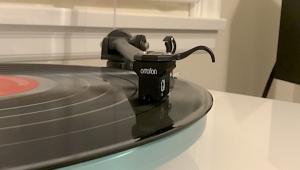Any recommendation for a good, low-cost, digital 'scope to comfortably handle the audio range and raw output from low-output moving coils up through OTL tubed output stages to drive electrostatics?
Soundsmith Strain Gauge SG-200 phono cartridge system Page 3
The Strain Gauge's recommended range of VTF is 1.7–1.9gm. Though the cartridge can theoretically track as low as 1gm and as high as 2.5gm, neither setting is recommended. I went with 1.8gm.

And now for something completely different
Remember the first time you heard a pure electrostatic speaker, and how fast, open, detailed, and free of gross cabinet colorations it sounded? That was pretty much my experience of listening to the Soundsmith Strain Gauge SG-200 for the first time, though like electrostats, the Strain Gauge had a particular sonic quality that some will love and others won't—and, of course, it will flatter some records and render others unpleasant.
As quoted on Soundsmith's website, someone from the Mid-Atlantic Audiophile Group said that the Strain Gauge "leapfrogs the finest moving-coil cartridge." Well, it certainly did that in some respects, and convincingly, too—just as electrostats leapfrog moving-coil speakers—in some ways. The sound the Strain Gauge produced was, like that of every other cartridge I've ever heard, distinctive. Some will fall in love, others will run like hell—and from the same qualities.
Well, count me among the wide-eyed—at least when it came to the Soundsmith system's incredibly clean and fast top-to-bottom transient attack, its spectacular transparency, its taut, deep bottom end, and its airy top. This thing stopped and started faster than any cartridge I've ever heard. The speed and precision of its instrumental attack set new standards for phono cartridges, in my experience, as did its overall transparency and its rhythm'n'pace. In the best sense, it made my Wilson Audio Specialties MAXX 3 speakers sound like electrostatics, but with full bass extension and dynamic capabilities.
With either of its two supplied styli, the SG-200 traced the groove as well as any cartridge I've used and better than most, particularly in its tracking of HF transients and vocal sibilants. If there were any lumps or bumps in its frequency response, they were difficult to hear, though after a while I think I found a midband trough. Still, the SG-200's overall tonal neutrality was unquestionably superior to all but a few of the best cartridges I've heard through the best phono preamps. Its background blackness never failed to amaze me, and its generously wide, deep, tall soundstage indicated unusually low levels of crosstalk (which I confirmed by measurements). But none of that means that everyone will enthuse about how it actually sounded.
With the top-of-the-line SGS-6 stylus in place, I auditioned a recent remastering of Paul McCartney and Wings' Band on the Run (Hear Music/Concord Music Group UMG 8 88072 32566 1). The percussion in "Bluebird" was positively astonishing: razor-sharp, as in "utterly natural," without being brittle or etched. The acoustic guitars, tom-toms, and bass lines in "Mrs. Vandebilt" were so cleanly and precisely rendered, so naturally fast and taut, that my ear/brain couldn't help but be drawn in and transfixed by the novelty of the sound compared to that of any standard cartridge.
That stop-and-start ability, that freedom from overhang that audiophiles often confuse with "warmth," are leapfroggings in performance over more usual cartridge designs—yet the SG-200's delivery was so fast and clean that there was little time for harmonic development to unfold before it was off to the next aural event. So while the attack was extraordinary, the sustain was somewhat stingy. The SG-200 could sound somewhat cool and lacking in physicality, and while its top was crystalline and airy and its bottom tight, deep, and well textured, the mids were less than fully fleshed out, making the overall sound somewhat cool and slightly recessed.
When I played the same copy of Band on the Run with the Ortofon A90 cartridge, I got a totally different but equally valid performance that, in its own way, leapfrogged the Strain Gauge: There was more weight and, especially, texture in the bottom end, more follow-through of the instrumental harmonic structure, more "skin" in the toms, more flesh in the voices, and, in general, more roundness and body to further flesh out the three-dimensional picture. But the magnetic Ortofon does sound slower, less well defined, and, particularly, somewhat less transparent and immediate than the SG-200.
Playing the essential 45rpm reissue of Nat King Cole's Love Is the Thing (LP, Capitol/Analogue Productions SW-824) with the SG-200, I was quickly made aware of the vocal microphone's rising high end. The bow scrapes on the strings get greater emphasis, the sheen and woody resonance somewhat less. Cole's chest cavity plays second fiddle to his vocal cords and mouth. Through the Ortofon A90, the emphasis was reversed. Which you will prefer will depend on your system and taste.
But consider that for $5600, the SG-200 Strain Gauge is complete. The $4200 A90 still needs a phono preamp, and in this case I used the $28,000 Ypsilon VPS-100, along with a few other top-shelf tubed and solid-state preamps—and the two systems were on a reasonably level playing field in terms of macrodynamic slam, HF extension, and resolution of detail. With a good magnetic cartridge, however, you can alter the flavor as necessary by changing the phono preamp. That's not the case with the Strain Gauge, which is what it is.
- Log in or register to post comments




















































